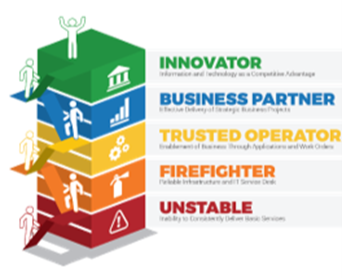
Driving Business Efficiency Through the Alignment of IT Service Delivery
I have been approached by C-Level executives with a common question, “How do I eliminate the disconnect between the efforts produced by my IT Department and the perception of their service delivery by internal staff? The two are asymmetric!”
The alignment of a company’s Information Technology Service Delivery and its internal Business Consumer can be a moving target for many small to medium sized businesses.
Often, IT is perceived as hard working but producing limited work products or is slow to produce value to its end consumer, the Business. Interestingly, the disconnect has a hidden synergy requiring further introspection.
The following breaks down these perceptions with a solution aligning IT and the Business in a more harmonious and interactive way.
Business Perception 1:
Delivery of requested requirements do not meet expectations
There is a classic visual representation for this phenomenon. Everyone, being human, takes their own experiences into how communication is delivered and understood.
Sometimes there is a language barrier between what the Business is requesting and how IT interprets the needed support. When this happens, there becomes an obvious disconnect between the requestor and the service provider.
Business Perception 2:
IT is unable to Deliver Services within desired timelines
Many businesses started small and have grown homogeneously over time. Often, their IT staff also started small but did not grow in proportion with the Business. Frequently this is done to reinvest in other non-IT related aspects of the Business (e.g., hiring more staff, increasing product speed-to-market, or expansion of services).
Unfortunately, when IT investment (staff, skillset, or toolset/infrastructure) does not grow incrementally with Business expansion, then the Business starts acquiring Technical Debt.
What is Technical Debt? The industry defines this as a budgetary decision, based on present Business opportunities or circumstances, that forgoes the investment in IT resulting in the depletion of IT’s ability to provide the required service delivery in the future. For example, delaying a monetary decision to upgrade the organizations aging desktop fleet results in latent computer response time, thus slowing down the efficiency of the workforce.
It also introduces vulnerabilities as Operating System manufacturers stop releasing security patches for those aged systems. This latter example creates a circumstance where an imminent security vulnerability could negatively impact the Business on a profound scale.
The last example of Technical Debt is not growing IT staff and skillsets in a proportionate ratio of the number of employees supported. In this scenario the supply of technical resources cannot keep up with the demand for services requested. This commonly results in IT services being delivered outside of desired timelines. The cost of Technical Debt increases with time and can become a slippery downward slope. However, Technical Debt can be mitigated.
Solution
IT is the underpinning support enabling the business to produce its products or services. Orchestrating your Business users and IT staff in harmony is essential to success. Following is an approach to bring symmetry to operations.

1. Develop the Mission and Vision of the Business if none exists.
2. Evaluate your overall Organizational Maturity. Are there aspects that can be improved? Create a Three-Year Strategic Business Plan with targeted goals increasing Organizational Maturity alongside other growth-related business goals. Ensure goals are feasible, obtainable, realistic, and require both IT and the Business to implement aspects of those goals together.
3. Assess IT’s Service Delivery Maturity. Are they Unstable? In constant Firefighting mode? Aligned as a Trusted Operator? Already a Business Partner? Or are they a full-on Innovator? If the assessment does not fall within the Business Partner or Innovator levels, work with IT to create a Three-Year IT Roadmap aligning with the Strategic Business Plan, Mission, and Vision. Periodically measure business stakeholder satisfaction throughout implementation of the IT Roadmap to measure gains or identify delivery aspects requiring further improvement. If internal resources are spread too thin to facilitate the assessment and IT Roadmap, reach out to a reputable consulting firm who can provide access to evaluation tools and assist with your planning.
4. Create an IT Steering Committee of key stakeholders consisting of a small but core group of strategic Business and IT leaders. This Committee should report to an Executive Stakeholder and collaboratively select the core IT investments required by the Business and provide principal oversite on execution and budgetary allocation.
Rome wasn’t built in a day. Give the organization time necessary to complete the above recommendations in a useful and impactful way. Ensure your strategic goals have metrics to measure whether they are being achieved. Carefully plan for budget to support these goals over a specified timeline. Adopt an organizational value set that facilitates both IT and the Business dialing into the frequency from which each is communicating to fully understand the context and intent of the Service Request and its fulfillment within Service Delivery. And lastly, continue to drive synergy and innovation by celebrating the incremental wins together.
Bridging the gap between IT and business needs can unlock remarkable efficiency and innovation, but it requires the right strategy and alignment. If your organization is ready to assess your IT maturity, reduce technical debt, and create real synergy between IT and business teams, let’s talk!
Book a quick intro meeting to explore how we can help you align IT with your business objectives and set a path toward sustainable growth.

